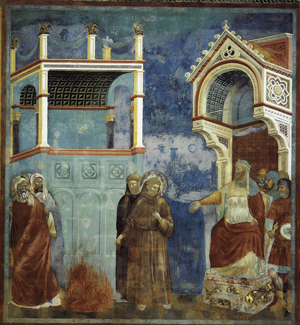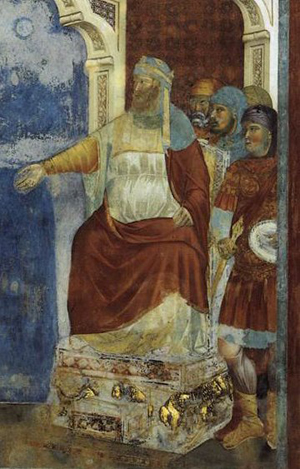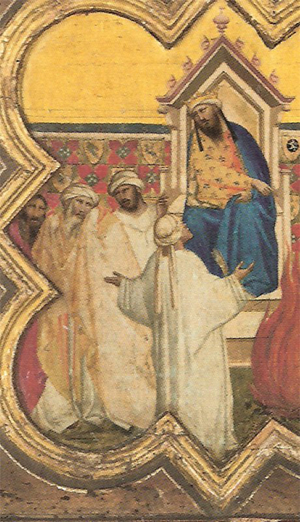In the Alte Pinakothek of Munich (Germany), we can see, from tje painter Taddeo Gaddi (1300-1366) a student of Giottto, one of the first representations of a Kurdish prince in Western painting. It is not a Saladin’s portrait, -thought the former is the most famous Kurd in the Middle-Age- but his nephew,al-Malik al-Kamil Nasir al-Dîn Abû-l-Ma’alî Muhammad, the son of Sultan al-Malik al-Adil, who ruled Egypt in the name of his father when the event pictured there happened, in 1219.
Al-Malik al-Kamil faced in Egypt the Vth Crusade in Damietta. Franks could size the fortress al-Silsila (the Chain) and then took Damietta. But al-Kamil, who became the same year Sultan after his father’s death, surroundered and besieged Frank forces until his brothers al-Ashraf, al-Mu’azzam and then of other Ayyubids came to help him in 1221 (2 years later, let’s appreciate the celerity of the familial solidarity).
Saint Francis of Assisi came also with the Crusaders but for a peaceful pilgrimage. He went even to meet the Sultan who welcomed him with respect and tried to challenge the Muslim to a test of true religion by fire; but they retreated. Then as his follower told, Francis proposed to enter in the fire first and, if he left the fire unharmed, the sultan would have to recognize Christ as the true God. Al-Malik al-Kamil did not allow him to preach Christianism in Egypt but let him comingback freely to the Frank camp, telling, according Jacques de Vitry, “Pray for me that God may deign to reveal to me that law and faith which is most pleasing to him.â€
Muslims sources did not mention the meeting. In fact, a such embassy was not exceptionnal for Egyptians or Syrians. Bounds and debates between Christians, Jews and Muslims were not rare and a peaceful monk like Francis, who had the aspect and the tolerance of a “Christian sufi†could be respected by Kurdish Ayyubids, who were traditinnally more tolerant toward Christians than the Turkish Nur al-Dîn, the predecessor of Saladin.
The story had been widely reported and commented in Italia, and painted by Giotto in the frescoes he made for the Church of Assisi.
But the Muslim group painted by Giotto appears as less realistic, and with a strange clothing, a mix of Western and Eastern elements : short dress without sarwal and bare legs ! Only their turban gives them an “ismamic touch†:
Gaddi’s representation, even if the Sultan wears a European golden crown, includes a group of muslims with jellabah and turbans more authentic :




Leave a Reply
You must be logged in to post a comment.